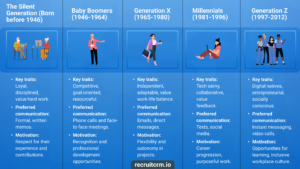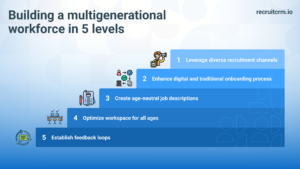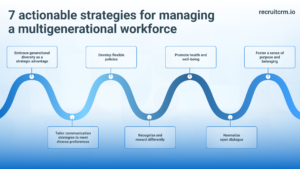Master the art of leading a multigenerational workforce with practical tips and FREE email templates covered in this guide.

What is a multigenerational workforce?
A multigenerational workforce is essentially a team made up of workers from several age groups.
As people extend their careers, it’s increasingly common for workplaces to host four to five generations working together harmoniously.
This team includes—
- The Silent Generation: born 1928-1945
- Baby Boomers: born 1946-1964
- Generation X: born 1965-1980
- Millennials: born 1981-1996
- Generation Z: born 1997-2012
A workforce with a different range of experience enriches the company with a wide array of diverse talents and perspectives.
Younger employees often inject fresh ideas and adapt swiftly to technological changes, while older teammates contribute a depth of knowledge and experience that’s invaluable for strategic decision-making.
The synergy between young talent and experienced folks fosters an environment ripe for innovation, enhanced problem-solving, and a wealth of learning and mentoring opportunities.
Also read: Elevating talent acquisition solutions: Pioneering strategies for the modern workforce
Are there any benefits of a multigenerational workforce?
Absolutely, a multigenerational workforce brings together diverse perspectives and skill sets to the table. This fosters creativity, innovation, and knowledge-sharing within the organization.
Let’s look at more benefits of building a multigenerational team:
1. Enhanced innovation and creativity
A multigenerational team combines the wisdom of experience with the freshness of new perspectives.
Older employees often have a deep understanding of industry nuances and a long view of business cycles, while younger team members may bring innovative thinking and familiarity with the latest technologies.
This blend can spark creative solutions to problems and drive innovation within the organization.
2. Diverse problem-solving approaches
Different generations approach problem-solving in varied ways, influenced by their unique experiences and educational backgrounds.
By leveraging these diverse approaches, companies can tackle challenges more effectively.
This team can offer a range of solutions, from tried-and-tested methods to cutting-edge strategies, enhancing the team’s ability to navigate complex issues.
3. Rich learning and mentorship opportunities
The presence of multiple generations in the workplace creates a natural environment for cross-generational learning and mentoring.
Think about it, experienced employees can share their knowledge and insights on industry trends, client management, and professional resilience.
In turn, younger employees can mentor their older colleagues on new technologies, social media, and current market trends.
This reciprocal learning fosters personal and professional growth across the team.
4. Enhanced employee engagement and retention
A workplace that values and leverages generational diversity is likely to foster a sense of belonging and engagement among its employees.
Recognizing and celebrating the unique contributions of each age group can boost morale and job satisfaction, leading to higher levels of employee engagement and retention.
When your people feel valued and understood, they are motivated to remain committed to your company.
Also read: What are new graduates looking for? The ultimate guide to recruiting Gen Z
5 simple ways to build a multigenerational workforce

1. Leverage diverse recruitment channels
To attract a multigenerational workforce, diversify your recruitment channels.
Traditional job boards might appeal to Gen X and Baby Boomers, while digital platforms like LinkedIn, Twitter, and even Instagram can attract Millennials and Gen Z.
Don’t overlook the power of career fairs, both virtual and in-person.
Also, consider employee referral programs that incentivize your current workforce to bring in talent from their networks, which are likely to span multiple generations.
2. Enhance digital and traditional onboarding process
Craft onboarding experiences that cater to both digital natives and those who prefer traditional methods.
Incorporate tech-savvy tools and apps into the onboarding process for younger employees. For older generations, ensure that personal interactions and paper-based resources are also available.
This dual approach ensures that all new hires feel welcomed and adequately supported from day one.
3. Create age-neutral job descriptions
When crafting job descriptions, focus on the skills and competencies required rather than the demographic you imagine filling the role.
Use inclusive language that speaks to candidates’ abilities and potential contributions in different age groups, avoiding terms that might unconsciously appeal to a specific generation.
4. Optimize workspace for all ages
Design work environments that cater to the needs and preferences of a diverse age group.
This could mean offering a mix of open-plan spaces for collaboration, quiet areas for focused work, and ergonomic setups that accommodate physical comfort for all employees.
A versatile workspace acknowledges the varying work styles and needs, promoting productivity and satisfaction across generations.
5. Establish feedback loops
Create mechanisms for employees to share their insights, concerns, and suggestions regarding age diversity and inclusion within the organization. This could be through surveys, focus groups, or feedback sessions.
Listening to and acting on feedback from employees at different stages can help you refine your strategies and ensure they meet the needs of your diverse workforce.
What are the challenges of a multigenerational workforce?
1. Preferred communication styles
There is a huge generational difference when it comes to communication styles.
For example, Baby Boomers and Gen Xers may prefer direct communication methods like phone calls or emails, while Millennials and Gen Z might lean towards instant messaging or social media.
Finding a common ground that respects and integrates these preferences is crucial for effective teamwork.
2. Stereotypes
Stereotypes can create barriers to understanding and collaboration. Older employees might be unfairly viewed as resistant to change, while younger workers could be perceived as lacking work ethic.
These stereotypes undermine individual contributions while dampening morale and productivity.
3. Technology
The importance of tech in a modern workplace cannot be overstated, but comfort levels with digital tools can vary widely among generations.
Leaders must leverage technology to enhance productivity and collaboration without excluding those less comfortable with new tools.
4. Dress code
Dress code preferences can vary significantly across generations, with some preferring formal attire and others leaning towards a more casual approach like cocktail attire for men and blazers and skirts for women..
To bridge the gap, consider involving employees in discussions about attire policies and find a balance that respects individual expression while maintaining a professional standard that aligns with the organization’s identity.
5. Workplace relationships issues
Older workers often adopt a more traditional approach towards relationships at work, adhering to the belief that professional environments should be strictly separate from personal matters.
But, the modern workplace places a significant emphasis on mental health and well-being, encouraging open discussions on a broad spectrum of topics.
While some team members are open to addressing issues once considered private, others may view these topics as inappropriate for the workplace.
6. Learning preferences
The one-size-fits-all approach to training doesn’t work in a multigenerational workforce.
Traditional in-person training sessions may resonate with some, but online modules or interactive workshops might be more effective for others.
Leaders should offer a range of learning opportunities that cater to different styles, promoting a culture of continuous, inclusive learning.
You might also like: An actionable guide on recruiting, training, and incentivizing recruiters
7 actionable strategies for managing a multigenerational workforce

1. Embrace generational diversity as a strategic advantage
The first step in managing a team of multiple generations is to view generational diversity not as a challenge but as a strategic advantage.
Each age group brings unique skills, perspectives, and experiences that, when harnessed correctly, can lead to innovative solutions, a more dynamic workplace culture, and improved business outcomes.
Focus on actively promoting the value of diverse generational insights and encouraging cross-generational learning and collaboration.
2. Tailor communication strategies to meet diverse preferences
Effective communication is the cornerstone of any successful team, and this becomes even more critical in a multigenerational setting.
Understanding and accommodating the preferred communication styles of different generations can significantly enhance team cohesion and productivity.
This might mean balancing traditional methods, such as face-to-face meetings and emails, with more modern approaches, such as instant messaging and collaboration platforms.
3. Develop flexible policies
Flexibility in work arrangements, benefits, and policies is crucial to meet the varied needs of a multigenerational workforce.
This includes offering flexible working hours, remote work options, and tailored benefits packages that appeal to different life stages and priorities.
Such policies not only demonstrate an organization’s commitment to accommodating individual needs but also contribute to higher job satisfaction and retention rates across all generations.
4. Recognize and reward differently
Recognition and rewards are powerful motivators, but what is valued can vary significantly across generations.
While some may prefer public recognition and career advancement opportunities, others might value additional time off or flexible work arrangements.
Try to implement a diverse recognition program that allows employees to choose their preferred form of reward.
5. Promote health and well-being across the board
A focus on health and well-being is crucial in today’s workplace, and this includes catering to both physical and mental health needs.
Offer health benefits and wellness programs that address a wide range of health concerns and life stages, from fitness memberships and mental health support to retirement planning and healthcare options.
Remember, encouraging a healthy work-life balance is also key to supporting the overall well-being of your team.
6. Normalize open dialogue
Creating an environment where open discussions about generational expectations and values are normalized can significantly enhance mutual understanding.
Encourage team members to share their work preferences, career aspirations, and what they value in a workplace.
This not only helps in tailoring management approaches but also fosters a culture of respect and empathy across different age groups.
7. Foster a sense of purpose and belonging
Finally, ensuring that employees across all generations feel a strong sense of purpose and belonging within the organization can drive engagement and retention.
Communicate the company’s vision and how each role contributes to the larger goals.
Create opportunities for employees to engage with the community and contribute to social causes, aligning with the growing desire among workers to be part of something meaningful.
Don’t miss out: How to support & manage mental health as a recruiter?
What are some misconceptions about a multigenerational workforce?
The presence of a multigenerational workforce can sometimes give rise to misconceptions that may hinder organizational harmony and productivity. Here are some common myths and the reality behind them:
Myth 1: Generational conflict is inevitable
While different generations may have varying perspectives and work styles, these differences don’t automatically lead to conflict.
In fact, when managed well, such diversity can lead to more creative problem-solving and innovation.
Effective communication and mutual respect are key to turning potential conflicts into collaborative strengths.
Myth 2: Older workers resist technology
The idea that older employees are not tech-savvy is outdated. Many individuals in older generations are just as capable of adapting to new technologies as their younger counterparts.
The key is providing access to training and support that addresses the learning needs of all employees, fostering a culture of continuous learning.
Myth 3: Young workers lack work ethic
Younger generations, such as Millennials and Gen Z, are often stereotyped as having a lower work ethic, a relaxed working approach, and less loyalty to employers.
However, their work values are simply different. They may prioritize meaningful work, flexibility, and work-life balance more than previous generations.
When these needs are met, younger workers can be just as committed and hardworking.
Myth 4: Multigenerational workforces are harder to manage
While managing a diverse age group may require different approaches, it’s not necessarily harder.
It involves leveraging each generation’s strengths, fostering an inclusive culture, and adapting management practices to meet varied needs.
The benefits of increased innovation, diverse problem-solving, and rich mentorship opportunities often outweigh the challenges.
Free sourcing email templates for reaching out to multiple generations
Let’s look at email templates that attract candidates from different age groups for the same position, i.e., marketing manager.
Note: Please adjust the templates according to the job role you’re hiring for.
1. For Gen Z
Subject Line: Start your Marketing Career with [Company Name]
Dear [Candidate Name],
Your LinkedIn profile is unique. We’re currently seeking a Marketing Specialist eager to tackle challenges and make a tangible impact from day one, and you seem the best fit for the position.
At [Company Name], we’re at the forefront of digital innovation, constantly exploring new horizons in marketing.
Why consider [Company Name]?
- Innovative projects: Work on groundbreaking marketing campaigns that set industry standards.
- Dynamic team environment: Collaborate with a team of creative and tech-savvy professionals who are shaping the future of marketing.
- Growth opportunities: We’re committed to your professional development, offering extensive training programs and mentorship to fuel your career trajectory.
We believe your fresh perspective and digital fluency could make a significant contribution to our team. If you’re interested in joining a company where innovation and creativity are at the heart of everything we do, we’d love to discuss this opportunity with you further.
Best regards,
[Your Name]
[Your Position]
[Company Name]
[Contact Information]
Note: This template emphasizes digital innovation and growth opportunities, appealing to Gen Z’s desire for career development and working with cutting-edge technologies. The mention of a dynamic team environment caters to their preference for collaborative and tech-savvy workplaces.
2. For Millennials
Subject Line: Elevate your Marketing Career at [Company Name]
Dear [Candidate Name],
Greetings from [Company Name]. As a company that prides itself on driving meaningful change through marketing, we understand the importance of purpose-driven work. We’re looking for a Marketing Specialist who is passionate about making a difference and ready to take their career to the next level.
Why join us?
- Impactful work: Contribute to campaigns that not only achieve business goals but also promote social and environmental responsibility.
- Work-life balance: Enjoy flexible working hours and a supportive culture that values your well-being.
- Collaborative culture: Be part of a team that values open communication, creativity, and mutual respect.
Your experience in developing compelling marketing strategies and your commitment to making a positive impact aligns with our mission. We’re excited about the possibility of having you on our team.
Warm regards,
[Your Name]
[Your Position]
[Company Name]
[Contact Information]
Note: Focused on purpose-driven work and work-life balance, this template aligns with Millennials’ values of making a positive impact and seeking a supportive culture. It highlights the collaborative nature of the company, which is important for Millennials who value teamwork and open communication.
3. For Gen X
Subject Line: Leverage your Marketing Expertise in a leadership role at [Company Name]
Dear [Candidate Name],
At [Company Name], we recognize the invaluable contribution of experienced professionals to our success. We’re currently seeking a Marketing Specialist with a strategic vision and a proven track record to guide our marketing efforts to new heights.
Why [Company Name]?
- Leadership opportunities: Use your expertise to lead innovative marketing projects and mentor emerging talent within our team.
- Stable growth: Join a company with a solid market presence and a clear vision for the future.
- Professional development: Benefit from tailored development programs designed to enhance your skills and leadership capabilities.
We admire your extensive experience in the marketing field and believe your leadership could greatly enhance our team’s capabilities.
If you’re looking for an opportunity to apply your strategic insight and drive impactful marketing initiatives, we would be delighted to discuss how you can make a difference at [Company Name].
Kind regards,
[Your Name]
[Your Position]
[Company Name]
[Contact Information]
Note: This template targets Gen X’s appreciation for leadership opportunities and stable growth. It acknowledges their extensive experience and offers professional development, catering to their desire for recognition and the ability to contribute significantly to the company’s success.
4. For Baby Boomers
Subject Line: Share your wealth of Marketing Expertise with [Company Name]
Dear [Candidate Name],
[Company Name] has long valued the deep knowledge and strategic acumen that seasoned professionals bring to our team. As we seek to expand our marketing department, we’re looking for a Marketing Specialist who can offer wisdom, mentorship, and innovative thinking.
Why consider us?
- Mentorship role: Share your extensive marketing expertise with younger team members, shaping the future of our marketing efforts.
- Respect for experience: Work in an environment that appreciates your years of experience and contributions to the field.
- Commitment to growth: Even at this stage in your career, we offer opportunities for learning and professional development that align with your vast experience.
Your distinguished career in marketing positions you perfectly to contribute to our team’s success. We’re eager to discuss how your expertise can further our company’s goals and continue your legacy of excellence.
Sincerely,
[Your Name]
[Your Position]
[Company Name]
[Contact Information]
Note: Tailored to Baby Boomers, this template emphasizes mentorship roles and respect for experience, recognizing their valuable contributions over the years.
Check out: Your secret weapon in successful recruitment
As we move forward, it’s clear that the organizations that will thrive are those that view generational diversity not as a challenge to overcome but as an opportunity to embrace.
Frequently asked questions
1. How to engage a multigenerational workforce?
To effectively engage a multigenerational workforce, implement flexible work options, utilize varied communication tools, and offer benefits tailored to different life stages.
You can also promote cross-generational mentorship and teamwork to capitalize on the unique strengths of each age group.
2. What are effective ways to train staff on inclusivity and diversity in a multigenerational setting?
For inclusivity and diversity training in a multigenerational setting, use interactive workshops, role-play, and awareness programs.
Also, try to highlight the importance of diverse perspectives through case studies and encourage open dialogue to build empathy.
3. How can I motivate a multigenerational workforce?
To motivate employees across generations—
a. Recognize individual contributions.
b. Offer professional development opportunities.
c. Provide customized benefits.
d. Create a respectful and inclusive work environment with flexible working conditions where every contribution is valued.
4. How can I enable young leadership to manage older colleagues?
Provide training focused on emotional intelligence, communication, and conflict resolution to support young leaders in managing older colleagues.
Ensure building a culture of respect for the experience older colleagues bring while promoting mutual learning and collaboration.




